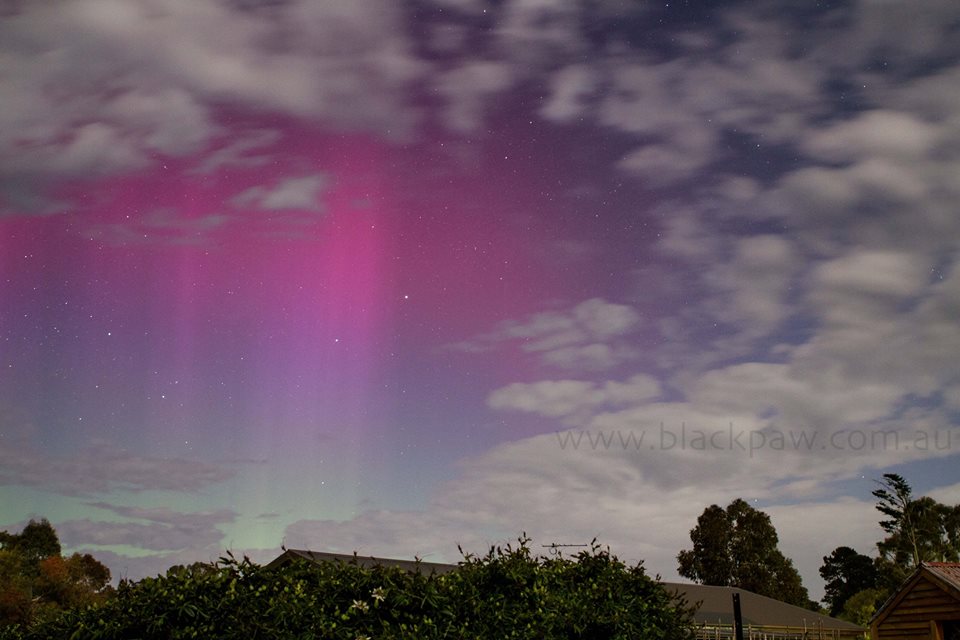Sunspot region 2205, active aurora
Tuesday, 4 November 2014 15:51 UTC

Solar activity during the past 24 hours was high. Newly numbered sunspot region 2205 is now rotating into view and it already produced four M-class solar flares during the past 48 hours. Two M-class solar flares yesterday (M2.2, M6.5) and two M-class solar flares (M2.6 and M2.3) today. A majority of these solar flares were eruptive and launched coronal mass ejections. They were however directed away from Earth as sunspot region 2205 is still close to the east limb. Aurora conditions are also elevated right now possibly due to glancing blow effects of the 1 November filament coronal mass ejection. In this article we will take a closer look at these events.
Sunspot region 2205
Sunspot region 2205 has been fairly active during the past 48 hours with four M-class solar flare including an R2 event (M6.5) peaking yesterday at 22:40 UTC. Sunspot region 2205 is still rotating into view so more sunspots might still appear from behind the limb but the spots that have rotated into view do not look very large nor does the group seem to have a very complex magnetic layout. In fact, there seems to be a lot of faculae around this sunspot region which could indicate it is in a state of decay. We nontheless have to wait at least 24 hours before we can make an accurate judgement of this sunspot region's magnetic layour as it's proximity to the limb makes it difficult to analyse, along with the fact that there might be more sunspots still behind the limb.
All the other sunspot regions on the earth-facing disk are unremarkable and unlikely to produce strong solar flares.
Be sure to follow us on Twitter for live solar flares alerts.
Active aurora
Auroral conditions reached G1 minor geomagnetic storm levels thanks to what is likely a glancing blow coronal mass ejection passage from the 1 November filament eruption. The strength of the interplanetary magnetic field (IMF) increased suddenly to about 10nT yesterday and it has been fluctuating around that same level the entire day now. The direction of the IMF (Bz) was mainly northward but went mostly southward following a solar sector boundary crossing this morning at 6:30 UTC. Bz values lower than -10nT were recorded and resulted in one period of minor G1 geomagnetic storming.
G1 - Minor geomagnetic storm (Kp5o) #aurora - Follow live on http://t.co/Gj5cI2OO1z pic.twitter.com/Oq4fps2and
— SpaceWeatherLive (@_SpaceWeather_) 4 november 2014
The direction of the IMF is now again mostly northward but we can not exclude that we see another period with southward directed IMF which could boost the auroral activity up to active (Kp4) conditions. High latitude sky watchers in large parts of Scandinavia, Scotland and Finland should remain alert for aurora if the direction of the IMF turns south again in the coming hours. The stunning image below was captured just a few hours ago by Blackpaw Photography from Tasmania, Australia.

Images: NASA SDO and Blackpaw Photography.
Today 11 years ago - X28 solar flare
It is today exactly 11 years ago that sunspot region 486 erupted with a massive X28 solar flare which might have been as strong as X45 according to some sources. This was the largest solar flare in modern times and it was the end of a period known as the Halloween solar storms of 2003 with extreme aurora for several days here on Earth. Last year we made a special video to celebrate these so called ''Halloween solar storms of 2003'' and today we want to show it to you one more time.
Thank you for reading this article! Did you have any trouble with the technical terms used in this article? Our help section is the place to be where you can find in-depth articles, a FAQ and a list with common abbreviations. Still puzzled? Just post on our forum where we will help you the best we can!
Latest news
Latest forum messages
Support SpaceWeatherLive.com!
A lot of people come to SpaceWeatherLive to follow the Sun's activity or if there is aurora to be seen, but with more traffic comes higher server costs. Consider a donation if you enjoy SpaceWeatherLive so we can keep the website online!

Latest alerts
07:15 UTC - 10cm Radio Burst
Begin Time: 01/04/2025 06:45 UTC Maximum Time: 01/04/2025 06:45 UTC Duration: 1 minutes. Peak flux: 190 sfu
07:06 UTC - Solar flare
Strong M5.61 flare
06:48 UTC - Radio Blackout
Moderate R2 radio blackout in progress (≥M5 - current: M5.36)
06:45 UTC - Radio Blackout
Minor R1 radio blackout in progress (≥M1 - current: M1.7)
02:15 UTC - Solar protons
Moderate S2 Solar Radiation Storm - Infrequent effects on HF radio through polar regions and satellite operations
Space weather facts
| Last X-flare | 2025/03/28 | X1.1 |
| Last M-flare | 2025/04/01 | M5.6 |
| Last geomagnetic storm | 2025/03/27 | Kp5 (G1) |
| Spotless days | |
|---|---|
| Last spotless day | 2022/06/08 |
| Monthly mean Sunspot Number | |
|---|---|
| February 2025 | 154.6 +17.6 |
| Last 30 days | 128.5 -22.7 |



